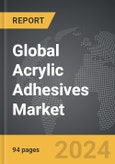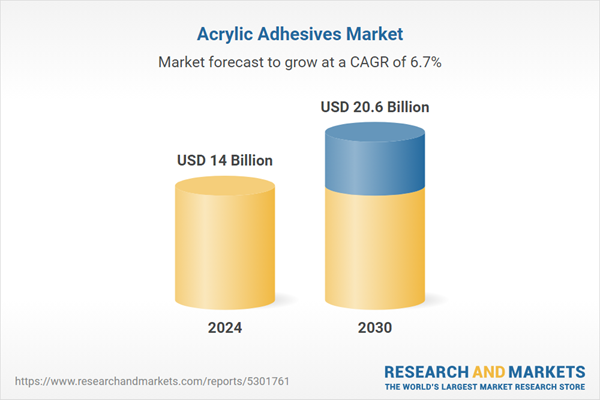Global Acrylic Adhesives Market - Key Trends and Drivers Summarized
Why Are Acrylic Adhesives Becoming a Go-To Solution in Modern Manufacturing?
Acrylic adhesives have gained widespread recognition as a critical solution in modern manufacturing and construction due to their versatile and high-performance bonding properties. But why are they becoming so indispensable? Acrylic adhesives are known for their strong bonding capabilities, durability, and ability to adhere to a wide variety of materials, including metals, plastics, glass, wood, and composites. This makes them an ideal choice for industries where robust and reliable bonding is essential, such as automotive, electronics, aerospace, and building construction. One of the key advantages of acrylic adhesives is their ability to form strong bonds quickly, often curing at room temperature without the need for additional heat or UV light. This rapid curing time increases productivity and efficiency in manufacturing processes. Moreover, these adhesives offer excellent resistance to environmental factors like moisture, temperature fluctuations, chemicals, and UV light, making them suitable for both indoor and outdoor applications. Their flexibility and strength allow them to maintain adhesion even under stress or in challenging conditions, which is why they are increasingly replacing traditional fastening methods like screws, bolts, and welding in many applications.Where Are Acrylic Adhesives Making the Biggest Impact?
Acrylic adhesives are making a significant impact across a variety of industries, where their unique properties offer solutions to complex bonding challenges. In the automotive industry, for example, acrylic adhesives are widely used for assembling components like body panels, windshields, and interior trim. Their ability to bond dissimilar materials and withstand extreme temperatures and vibrations makes them ideal for this sector, where durability and performance are paramount. Similarly, in the electronics industry, acrylic adhesives are used to secure components, seal enclosures, and provide thermal management, as they can handle both the delicate nature of electronic parts and the harsh environments in which many devices operate. The aerospace industry also relies on acrylic adhesives for bonding lightweight materials used in aircraft and spacecraft, where weight reduction is critical without compromising strength. In the construction sector, acrylic adhesives are used for flooring, paneling, and insulation installation, as they provide a strong bond while allowing for flexibility in materials and surfaces. Additionally, these adhesives are increasingly being used in the renewable energy industry, particularly in the assembly of solar panels and wind turbines, where their ability to withstand extreme weather conditions is invaluable. The diverse applications of acrylic adhesives across these industries highlight their versatility and the growing demand for efficient, reliable bonding solutions.What Technological Innovations Are Shaping Acrylic Adhesives?
The advancement of acrylic adhesive technology has been driven by innovations that improve performance, sustainability, and ease of use. One of the most notable technological developments in recent years is the creation of structural acrylic adhesives that offer exceptional strength and can replace mechanical fasteners like rivets and welds in high-stress applications. These adhesives not only provide strong bonds but also distribute stress more evenly across bonded surfaces, leading to longer-lasting and more durable assemblies. Another key innovation is the development of low-odor and low-emission acrylic adhesives, which address health and environmental concerns in manufacturing environments. These eco-friendly adhesives are designed to meet stringent environmental regulations while maintaining high performance, making them particularly attractive in industries where sustainability is becoming a top priority. Additionally, advancements in adhesive curing technology have led to the introduction of UV-curable acrylic adhesives, which cure almost instantaneously when exposed to ultraviolet light, significantly reducing production times. This has been a game-changer for industries like electronics and medical devices, where precision and speed are critical. Moreover, smart adhesive formulations that can adapt to different environmental conditions, such as temperature and humidity, are emerging, making acrylic adhesives more reliable in dynamic settings. The continuous improvement of adhesive technology is expanding the scope of what acrylic adhesives can achieve, providing manufacturers with more efficient, cost-effective, and sustainable bonding solutions.What's Driving the Expansion of the Acrylic Adhesives Market?
The growth in the acrylic adhesives market is driven by several key factors, each reflecting the evolving needs of modern industries and advances in adhesive technology. One of the primary drivers is the increasing demand for lightweight and high-performance materials in sectors like automotive, aerospace, and construction. As manufacturers strive to reduce the weight of vehicles, aircraft, and building materials without sacrificing strength, acrylic adhesives have become a preferred choice due to their ability to bond dissimilar materials and offer structural support. Additionally, the shift towards electric vehicles (EVs) has boosted the demand for adhesives that can bond components while providing insulation and thermal management, further propelling the acrylic adhesive market. Another important factor is the rise of sustainability initiatives across various industries. Companies are seeking eco-friendly alternatives to traditional bonding methods, and low-emission, solvent-free acrylic adhesives are gaining traction as a more environmentally responsible solution. The construction industry's adoption of green building practices has also contributed to the increased use of acrylic adhesives, which help meet regulatory standards for sustainability and energy efficiency. Moreover, advancements in manufacturing processes, particularly in automation, are driving the need for fast-curing adhesives that can improve production speed and reduce downtime. Acrylic adhesives, with their quick curing times and versatile applications, are increasingly seen as a solution for optimizing these processes. Lastly, the expansion of emerging markets, particularly in Asia-Pacific, where infrastructure development and industrialization are on the rise, is contributing to the growing demand for acrylic adhesives. These factors, combined with ongoing innovations in adhesive technology, are fueling the growth of the acrylic adhesives market globally.Report Scope
The report analyzes the Acrylic Adhesives market, presented in terms of market value (US$ Thousand). The analysis covers the key segments and geographic regions outlined below.- Segments: Technology (Water-based, Solvent-based, Reactive & Others); Type (Acrylic Polymer Emulsion, Cyanoacrylic, Methacrylic, UV Curable Acrylic); Application (Paper & Packaging, Construction, Transportation, Electronics, Consumer, Medical, Other Applications).
- Geographic Regions/Countries:World; United States; Canada; Japan; China; Europe (France; Germany; Italy; United Kingdom; Spain; Russia; and Rest of Europe); Asia-Pacific (Australia; India; South Korea; and Rest of Asia-Pacific); Latin America (Argentina; Brazil; Mexico; and Rest of Latin America); Middle East (Iran; Israel; Saudi Arabia; United Arab Emirates; and Rest of Middle East); and Africa.
Key Insights:
- Market Growth: Understand the significant growth trajectory of the Water-based Technology segment, which is expected to reach US$10.2 Billion by 2030 with a CAGR of a 7%. The Solvent-based Technology segment is also set to grow at 6.2% CAGR over the analysis period.
Why You Should Buy This Report:
- Detailed Market Analysis: Access a thorough analysis of the Global Acrylic Adhesives Market, covering all major geographic regions and market segments.
- Competitive Insights: Get an overview of the competitive landscape, including the market presence of major players across different geographies.
- Future Trends and Drivers: Understand the key trends and drivers shaping the future of the Global Acrylic Adhesives Market.
- Actionable Insights: Benefit from actionable insights that can help you identify new revenue opportunities and make strategic business decisions.
Key Questions Answered:
- How is the Global Acrylic Adhesives Market expected to evolve by 2030?
- What are the main drivers and restraints affecting the market?
- Which market segments will grow the most over the forecast period?
- How will market shares for different regions and segments change by 2030?
- Who are the leading players in the market, and what are their prospects?
Report Features:
- Comprehensive Market Data: Independent analysis of annual sales and market forecasts in US$ Million from 2024 to 2030.
- In-Depth Regional Analysis: Detailed insights into key markets, including the U.S., China, Japan, Canada, Europe, Asia-Pacific, Latin America, Middle East, and Africa.
- Company Profiles: Coverage of players such as 3M Company, Avery Dennison Corporation, Bostik Sa, Dana Lim A/S, Dynea and more.
- Complimentary Updates: Receive free report updates for one year to keep you informed of the latest market developments.
Some of the 43 companies featured in this Acrylic Adhesives market report include:
- 3M Company
- Avery Dennison Corporation
- Bostik Sa
- Dana Lim A/S
- Dynea
- Franklin Adhesives and Polymers
- H.B. Fuller
- Henkel AG & Company
- Huntsman Corporation
- Illinois Tool Works Inc.
- Permabond LLC.
- Pidilite Industries
- Royal Adhesives & Sealants, LLC
- Sika AG
- The Dow Chemical Company
- Toagosei Co., Ltd.
This edition integrates the latest global trade and economic shifts into comprehensive market analysis. Key updates include:
- Tariff and Trade Impact: Insights into global tariff negotiations across 180+ countries, with analysis of supply chain turbulence, sourcing disruptions, and geographic realignment. Special focus on 2025 as a pivotal year for trade tensions, including updated perspectives on the Trump-era tariffs.
- Adjusted Forecasts and Analytics: Revised global and regional market forecasts through 2030, incorporating tariff effects, economic uncertainty, and structural changes in globalization. Includes historical analysis from 2015 to 2023.
- Strategic Market Dynamics: Evaluation of revised market prospects, regional outlooks, and key economic indicators such as population and urbanization trends.
- Innovation & Technology Trends: Latest developments in product and process innovation, emerging technologies, and key industry drivers shaping the competitive landscape.
- Competitive Intelligence: Updated global market share estimates for 2025, competitive positioning of major players (Strong/Active/Niche/Trivial), and refined focus on leading global brands and core players.
- Expert Insight & Commentary: Strategic analysis from economists, trade experts, and domain specialists to contextualize market shifts and identify emerging opportunities.
Table of Contents
Companies Mentioned (Partial List)
A selection of companies mentioned in this report includes, but is not limited to:
- 3M Company
- Avery Dennison Corporation
- Bostik Sa
- Dana Lim A/S
- Dynea
- Franklin Adhesives and Polymers
- H.B. Fuller
- Henkel AG & Company
- Huntsman Corporation
- Illinois Tool Works Inc.
- Permabond LLC.
- Pidilite Industries
- Royal Adhesives & Sealants, LLC
- Sika AG
- The Dow Chemical Company
- Toagosei Co., Ltd.
Table Information
| Report Attribute | Details |
|---|---|
| No. of Pages | 391 |
| Published | January 2026 |
| Forecast Period | 2024 - 2030 |
| Estimated Market Value ( USD | $ 14 Billion |
| Forecasted Market Value ( USD | $ 20.6 Billion |
| Compound Annual Growth Rate | 6.7% |
| Regions Covered | Global |









